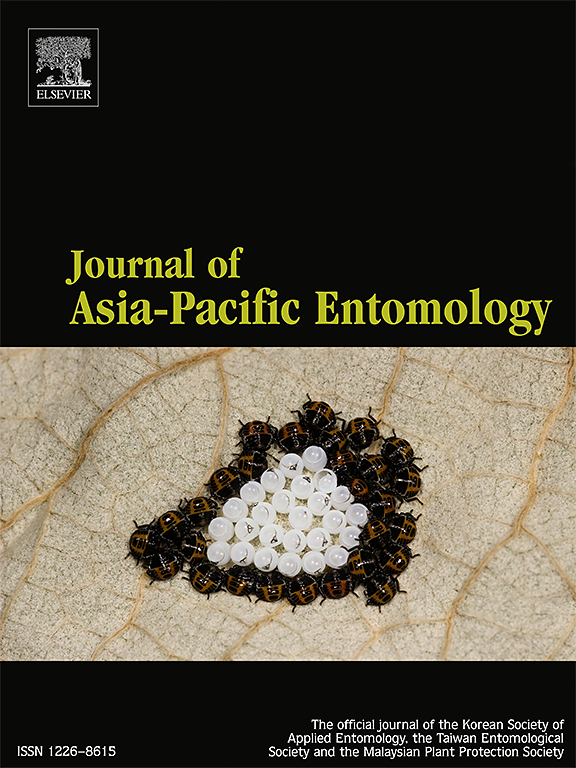New complete mitogenomes of four species in tribe Erythroneurini (Hemiptera: Cicadellidae: Typhlocybinae) from China and their phylogenetic analysis
IF 1.3
3区 农林科学
Q3 ENTOMOLOGY
引用次数: 0
Abstract
Erythroneurine leafhoppers are important insects in agriculture and forestry. The complete mitochondrial genomes of Motaga mengyangensis, Motaga acicularis, Tautoneura albida, and Tautoneura unicolor, which belong to the tribe Erythroneurini from China, were sequenced for the first time. The lengths of the complete mitogenomes of these four species ranged from 15,361 to 15,856 base pairs, and a typical set of 37 genes was identified in each. Among the 13 protein-coding genes (PCGs), except for the atp8 gene in T. albida and T. unicolor, which started with the codon TTG, the remaining genes all began with typical ATN codons (ATA/ATT/ATC/ATG). The stop codons were TAA, TAG, or an incomplete stop codon T. Utilizing three datasets from the mitochondrial genomes (PCGs, PCGsrRNA, and PCGs12rRNA) of 36 species (including two outgroups), phylogenetic trees of Erythroneurini were constructed via maximum likelihood and Bayesian inference methods. The results revealed that all phylogenetic trees supported the clustering of M. mengyangensis and M. acicularis into one evolutionary branch, as well as the clustering of T. albida and T. unicolor into another. Furthermore, all the results consistently supported the monophyly of genera within Erythroneurini and uniformly demonstrated that the genus Motaga formed a sister group relationship with the genus Empoascanara. Our research fills a crucial gap in the available data on complete mitochondrial genomes within Erythroneurini, laying a solid foundation for future explorations into the molecular aspects of leafhopper evolution and diversity, which further provides reference value for their prevention and control.

中国赤蝽科4种新的全有丝分裂基因组及其系统发育分析
红络素叶蝉是重要的农林昆虫。首次测定了中国红毛猴属蒙阳毛猴(mengyangensis)、针叶毛猴(acicularis)、白毛猴(Tautoneura albida)和单色毛猴(Tautoneura unicolor)的线粒体全基因组。这4个物种的完整有丝分裂基因组长度在15,361 ~ 15,856个碱基对之间,每个物种鉴定出一组典型的37个基因。13个蛋白编码基因(PCGs)中,除白衣t和独色t的atp8基因以密码子TTG开头外,其余基因均以典型的ATN密码子(ATA/ATT/ATC/ATG)开头。利用36个物种(包括2个外群)线粒体基因组(PCGs、PCGsrRNA和PCGs12rRNA)的3个数据集,通过极大似然和贝叶斯推理方法构建了红螺旋体的系统发育树。结果表明,所有系统发育树均支持孟阳柽柳和针叶柽柳在一个进化分支上的聚类,以及白毛柽柳和单色柽柳在另一个进化分支上的聚类。此外,所有结果一致支持赤藓属属的单系性,并一致证明Motaga属与Empoascanara属形成姐妹类群关系。我们的研究填补了现有红叶蛾线粒体全基因组数据的重要空白,为今后从分子层面探索叶蝉的进化和多样性奠定了坚实的基础,进一步为叶蝉的防治提供了参考价值。
本文章由计算机程序翻译,如有差异,请以英文原文为准。
求助全文
约1分钟内获得全文
求助全文
来源期刊

Journal of Asia-pacific Entomology
Agricultural and Biological Sciences-Insect Science
CiteScore
2.70
自引率
6.70%
发文量
152
审稿时长
69 days
期刊介绍:
The journal publishes original research papers, review articles and short communications in the basic and applied area concerning insects, mites or other arthropods and nematodes of economic importance in agriculture, forestry, industry, human and animal health, and natural resource and environment management, and is the official journal of the Korean Society of Applied Entomology and the Taiwan Entomological Society.
 求助内容:
求助内容: 应助结果提醒方式:
应助结果提醒方式:


